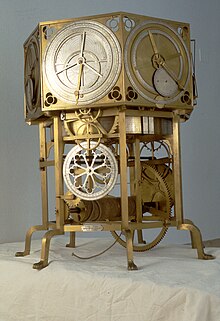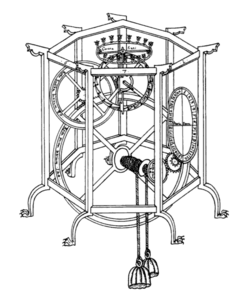Giovanni de Dondi

Giovanni de 'Dondi , also Giovanni Dondi dall'Orologio (* 1318 in Chioggia , Veneto , Italy , † June 22, 1389 in Milan , Lombardy ), was an Italian scholar and university professor . He developed the astrarium , one of the first public astronomical clocks in the world.
family
Giovanni was the son of the city physician Jacopo de Dondi (1290-1359), who worked as a teacher and doctor after studying at the University of Padua in Chioggia, but also occupied himself with astronomy and the construction of clocks.
Giovanni de 'Dondi was married twice. His first marriage was in September 1354 in Padua with Giovanna di Reprandino dalle Calze . From this marriage came the son Jacopo and four daughters. Immediately after the death of his first wife, he married Caterina di Gerardo da Tergola in July 1379 in Pavia and had four more children with her.
Life
Dondi, contemporary and later friend of the poet Francesco Petrarca (1304-1374), followed his father to the University of Padua in 1348, who had been a professor at the medical faculty there since 1342 , and lived with him across from the Pozzo Mendolo. After his studies Giovanni also became a medicine professor at this university around 1350/1352. In 1359 he became a member of the four faculties medicine , astrology , philosophy and logic ( mathematics ) and received recognition for his interdisciplinary teaching.
From 1368 to 1370 he was professor of medicine at the University of Florence . In 1371 Dondi was appointed ambassador to Venice and in 1372 he belonged to a group of five citizens who should seek better diplomatic relations between Carrara and the Venetian Republic. But in the same year he moved to a similar circle in Padua, which was considering a war against Venice.
After the Venice conflict, Dondi seems to have lost the favor of his previous patron Francesco de Carrara , the Prince of Padua. In the meantime, however, Dondi was friends with Gian Galeazzo Visconti (1351-1402) from Pavia, who lured him to his university with money and honors. So Dondi went to the University of Pavia , worked there as a professor and diplomat and lived (August 1382) in Visconti's palace. It was not until September 1387 that he built his own residence in Pavia.
During one of his last visits to Antoniotto Adorno , the Doge of Genoa , Dondi fell ill and died in Milan in 1389. His body was buried next to that of his father in the family crypt in Padua.
Astrarium
Dondi had come to astronomy and watchmaking through his father . With the support of Prince Ubertino de Carrara in Padua, he built a public striking clock for his Palazzo del Capitanio, which was built into the palace tower in 1344. However, the clock was destroyed in 1390 when the Milanese stormed the palace.
Giovanni became one of the most important astronomers of his time. Immediately after his arrival in Padua in 1348, he began designing and building his own astronomical clock, the so-called "Astrarium" or "Planetarium", a mechanical gear clock with weight drive and striking mechanism. He did not finish this work until 1364, 16 years later, and had his invention displayed in the large market square of Padua. This watch showed u. a. the course of the sun, moon and the then known five planets Venus , Mars , Saturn , Mercury and Jupiter around the earth as the center - according to the then prevailing Ptolemaic worldview (see also: Almagest ). In addition, the length of each day in hours and minutes, the exact date and the name of the saint to be honored were displayed for the first time. The original "Astrarium" went 1630 in Mantua lost, but models are available today in Milan's Museo Nazionale della Scienza e della tecnologia Leonardo da Vinci , the Washington National Museum of American History of the Smithsonian Institution , the Paris Observatory , the London Science Museum , in International Watch Museum La Chaux-de-Fonds and in the Watch Museum Beyer in Zurich (Switzerland).
Works
His most famous work is the Tractatus Astrarii , published in Padua in 1389, the reprint of which was reissued in 1960 by the Vatican Library in Rome and in 2003 by the Geneva publishing house Droz ( ISBN 2-600-00810-1 ).
literature
- Silvio A. Bedini, Francis R. Maddison: Mechanical Universe - The Astrarium of Giovanni de 'Dondi , in: Transactions of the American Philosophical Society, Volume 56, Part 5, Philadelphia 1966
- Henri Bach: The Astrarium of Giovanni de Dondi , in: Writings of the historical-scientific expert group “Friends of old clocks”, German Society for Chronometry (ed.), Volume XXIV / B special edition, Ditzingen 1985
- Lynn Thorndike: The Clocks of Jacopo and Giovanni de 'Dondi , in: Isis, Vol. 10, No. 2, University of Chicago Press, Chicago 1928
- GH Baillie, H. Alan Lloyd, FAB Ward: The Planetarium of Giovanni de Dondi, Citizen of Padua , in: Journal for the History of Astronomy, Vol. 6, p. 126, 1975
- Emmanuel Poulle (editor) Tractatus Astrarii: Giovanni Dondi dall'Orologio , Geneva, Droz 2003 (critical edition, Latin and French translation)
Fiction
- Hans Magnus Enzensberger : Mausoleum. Thirty-seven ballads from the history of progress . Suhrkamp Verlag, 1978, ISBN 3-518-01602-4
Web links
- Literature by and about Giovanni de Dondi in the catalog of the German National Library
- Search for Giovanni de Dondi in the SPK digital portal of the Prussian Cultural Heritage Foundation
- Literature list in the online catalog of the Berlin State Library
| personal data | |
|---|---|
| SURNAME | Dondi, Giovanni de |
| ALTERNATIVE NAMES | Dondi, Giovanni de '; Dondi dall'Orologio, Giovanni |
| BRIEF DESCRIPTION | Italian scholar, astronomer and inventor |
| DATE OF BIRTH | 1318 |
| PLACE OF BIRTH | Chioggia , Veneto , Italy |
| DATE OF DEATH | June 22, 1389 |
| Place of death | Milan , Lombardy , Italy |
